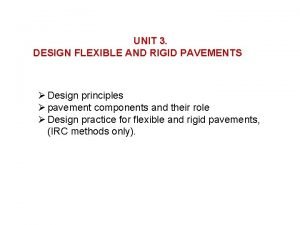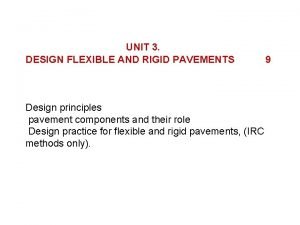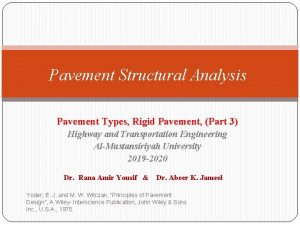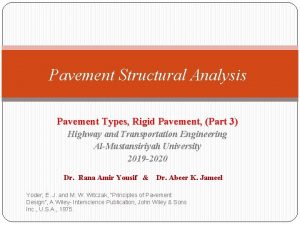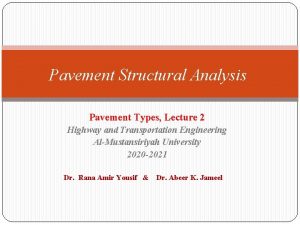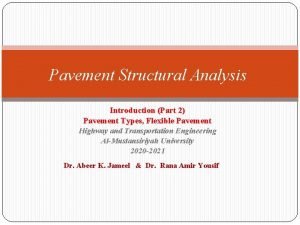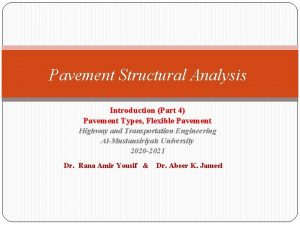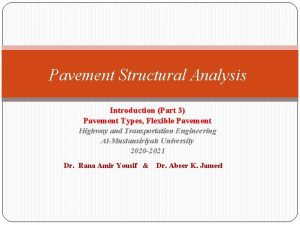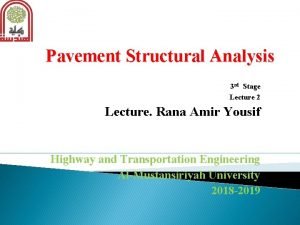Pavement Structural Analysis 3 rd Stage Lecture 4









- Slides: 9

Pavement Structural Analysis 3 rd Stage Lecture 4 Lecture. Rana Amir Yousif Highway and Transportation Engineering Al-Mustansiriyah University 2018 -2019

References: � Nicholas J. Garber and Lester A. Hoel. ”Traffic and Highway Engineering”, Fourth Edition. � Yoder; E. J. and M. W. Witczak, “Principles of Pavement Design”, A Wiley- Interscience Publication, John Wiley & Sons Inc. , U. S. A. , 1975. � Yaug H. Huang, “Pavement Analysis and Design”, Prentic Hall Inc. , U. S. A. , 1993. � “AASHTO Guide for Design of Pavement Structures 1993”, AASHTO, American Association of State Highway and Transportation Officials, U. S. A. , 1993. � Oglesby Clarkson H. , “Highway Engineering”, John Wiley & Sons Inc. , U. S. A. , 1975.

Types of Rigid Pavements Rigid pavements can be classified into four types: 1. Jointed Plain Concrete Pavement: are plain cement concrete pavements constructed with closely spaced contraction joints. Dowel bars or aggregate interlocks are normally used for load transfer across joints. They normally have a joint spacing of 5 to 10 m. 2. Jointed Reinforced Concrete Pavement: Although reinforcements do not improve the structural capacity significantly, they can drastically increase the joint spacing to 10 to 30 m. Dowel bars are required for load transfer. Reinforcement's help to keep the slab together even after cracks. 3. Continuous Reinforced Concrete Pavement: Complete elimination of joints is achieved by reinforcement. 4. Prestressed Concrete Pavements: Concrete is weak in tension but strong in compression. The thickness of concrete pavement required is governed by its modulus of rupture, which varies with the tensile strength of the concrete. The preapplication of a compressive stress to the concrete greatly reduces the tensile stress caused by the traffic loads and thus decreases the thickness of concrete required. The prestressed concrete pavements have less probability of cracking and fewer transverse joints and therefore result in less maintenance and longer pavement life.

Figure 1. 7: Four types of concrete pavements (1 ft = 0. 305 m).

Failure criteria of rigid pavements Traditionally fatigue cracking has been considered as the major, or only criterion for rigid pavement design. The allowable number of load repetitions to cause fatigue cracking depends on the stress ratio between flexural tensile stress and concrete modulus of rupture. Of late, pumping is identified as an important failure criterion. Pumping is the ejection of soil slurry through the joints and cracks of cement concrete pavement, caused during the downward movement of slab under the heavy wheel loads. Other major types of distress in rigid pavements include faulting, spalling, and deterioration.

1. 3 Composite Pavements: Composite pavement is composed of both HMA and PCC. The use of PCC as a bottom layer and HMA as a top layer results in an ideal pavement with the most desirable characteristics. The PCC provides a strong base and the HMA provides a smooth and non- reflective surface. However, this type of pavement is very expensive and is rarely used as a new construction. As of 2001, there about 97, 000 miles (155, 000 km) of composite pavements in the United States, practically all of which are the rehabilitation of concrete pavements using asphalt overlays. Figure 1. 8: Two different crosssections for composite pavements (1 in. = 25. 4 mm).

Difference between Flexible Pavements and Rigid Pavements:


